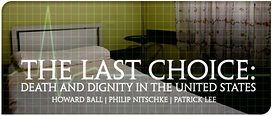Philip Nitschke and Patrick Lee offer very interesting responses to my essay. Philip Nitschke believes that the medicalization of suicide by means of a Death with Dignity statute is an “affront” to a person contemplating such a decision. Because suicide has been decriminalized throughout America, there is absolutely no need for PAD laws to regulate the action or for medical practitioners to involve themselves in a person’s planning to end his life. It is my life, my choice, my business. Neither the state nor the doctor has any role to play when a person decides to commit suicide.
My defense of PAD rejects Nitschke’s free-spirited anarchy. One practical reason for PAD is the inability of most persons contemplating suicide to legally acquire the drugs necessary to end life. As I noted in my essay, many potential suicides do not want to die by a bullet or a noose or some other macabre action if there are pills available—even if it means medical intervention in accordance with a PAD statute.
Another reason to support PAD statutes is because one clear goal of the law is to ensure that a person contemplating a “least worst death” is terminally ill, is competent, and is not clinically depressed. The Oregon and Washington state laws respect the integrity of the dying patient by ensuring that only psychologically healthy individuals can acquire the prescription for the lethal dosage they may wish to take to end their lives. There are serious checks and balances in the laws; they are barriers that prevent the onset of the slippery slope toward euthanasia.
Nitschke maintains that he works with and for “folk of independent mind and will.” A review of the characteristics of those in Oregon and Washington state who have availed themselves of the benefits of PAD are precisely such persons: independent adventurers, college-educated, who have lost their “meaningful prior life” because of the terminal illness. That reason, not unremitting pain and agony, is the one given by more than 95% of the patients in Oregon and Washington who sought PAD. Most dying patients want to live through pain and loss of facilities; in 2011 nearly 3 million persons died in America but only about 11,000 took their own life. Only an infinitesimally small number of these persons were terminally ill residents of Oregon or Washington who used the Death with Dignity statute.
Professor Patrick Lee categorically rejects my position and, I’m sure, Nitschke’s as well. The sanctity of life is at the heart of his argument, and I am sure he rejects my view that PAD laws do reflect a belief in the sanctity of life. For Lee, PAD is morally wrong and legally unlawful. It is morally wrong because the choice does not help the person attain or preserve an intrinsic good all humans possess—life itself. PAD, Lee argues, is contrary to the love and appreciation a person has for herself: one’s life is identical to oneself. It is morally wrong because it is a choice contrary to one’s intrinsic good. But, for me, a competent individual who is terminally ill can morally make a decision that life itself is no longer invaluable. Because of the tragic prognosis and significant changes in his life, it is no longer appreciated. For me, a person facing such a reality has the inalienable liberty to decide for herself that the time has come for the “least worst death.”
Contrary to Lee’s argument, I believe that Death with Dignity laws reflect a commitment to the sanctity of life by making it very difficult for a terminally ill patient to receive the lethal prescription and making it impossible for non–terminally ill elderly, or poor, or disabled, or chronically ill persons to end their lives with the passive assistance (by writing a prescription) of a medical practitioner. Unlike the Netherlands, supporters of PAD legislation are keenly aware of the specter of euthanasia and have structured the process to avoid the slippery slope. After more than a decade of PAD in Oregon, the data clearly indicates that only those who meet the burdensome criteria—which Nitschke disdains—have received lethal prescriptions. And some have died without filling the prescription.
Interestingly, Lee is critical of PAD laws because they differentiate between terminally ill, competent persons and all the other classes of persons. But such a careful delineation in these laws underscores the belief that life is precious and that, while suicide is no longer a crime, only in clearly circumscribed instances can a prescription be given to assist the dying person.
Lee also argues that individual autonomy and liberty is a limited legal right. It is appropriate to limit a person’s actions because of the general public’s need to protect life. And so seatbelt laws, the wearing of helmets by motorcyclists, and laws banning dueling are legal limits on one’s liberty (assuming there is effective enforcement). If the protection of life is not inviolate in society, then Lee believes that the most vulnerable citizens—the elderly, the disabled, the chronically ill—are in danger because they will receive greatly inferior care.
But this argument ignores some essential realities. There are very effective pressure groups representing the interests of these allegedly vulnerable cohorts as well as national and state laws that protect these persons. Court decisions over the past sixty years have validated these statutes and regulations.
Furthermore, since the middle of the last century, U.S. Supreme Court majorities have expanded individual rights and liberties for a large number of groups: the young, the old, married couples, minorities, single persons and school children. Individual liberties have inexorably expanded during these decades and this has not endangered the society.

